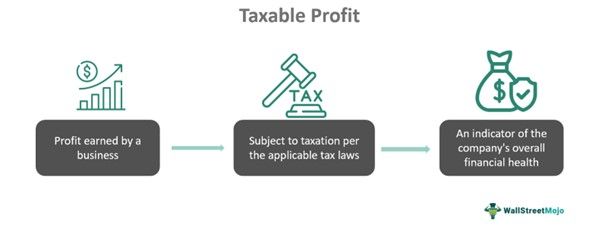Table Of Contents
Taxable Profit Meaning
Taxable Profit refers to the amount of profit for a specific duration, computed according to the rules and regulations established by tax authorities, upon which organizations need to pay income tax. It is an indicator of a company’s profitability and financial health.

The composition of such an amount varies depending on the tax authority. Primarily, the operating earnings of an organization form the basis of this amount. That said, other taxable earnings may come from interest income, capital gains, and dividend income. This amount directly impacts an entity’s tax liability. Moreover, it influences the taxpayer’s financial situation.
Key Takeaways
- Taxable profit definition refers to the earnings generated by a business on which the government levies tax. It is an indicator of a business’s profitability and financial health.
- Taxpayers must compute this amount accurately to avoid penalties or additional charges imposed by the government.
- People can compute this tax by deducting the total allowable business expenses or the tax-deductible expenses from the business’s total revenue.
- The tax-deductible expenses generally include depreciation, marketing expenses, rent, salary, etc.
- A key difference between taxable profit and accounting profit is that the former’s calculation does not take into account non-allowable business expenses.
Taxable Profit Explained
Taxable profit definition refers to the amount of a business’s profits that is subject to taxation. The computation of this profit depends on the tax laws established by a country’s taxation authorities and a business’s losses or profits recorded during a certain period, typically a year.
Such a profit serves as a crucial indicator of an organization’s profitability and financial health. Moreover, investors usually analyze taxable profits from business to evaluate a company’s ability to generate earnings and pay dividends consistently over time.
If businesses fail to calculate this amount correctly, they will end up reporting and paying an inaccurate tax amount to the government. As a result, they may end up paying hefty fines or penalties. Note that different tax rates may apply to such profits. Moreover, graduated tax rates may apply to taxable profit from business. Moreover, tax rates may vary based on the type of business, for example, partnership, company, proprietorship, etc. The tax rates, penalties, fines, etc., vary from one country to another because of the distinct tax systems.
How To Calculate?
Any person can determine this amount by taking into account every allowable business expense or deduction and subtracting them from the organization’s overall revenue. So, the general formula is as follows:
Taxable profit = Overall Business Revenue – Total Allowable Business Expenses
Where:
- Total Allowable Business Expenses include all tax-deductible costs linked with carrying out business-related operations. Examples of such items usually include wages and salaries, depreciation, business insurance, marketing expenses, rent, utilities, business license fees, etc.
- Overall Business Revenue includes the overall income earned by an organization from different sources, like royalties, sales, etc.
Examples
Let us look at a few taxable profit examples to understand the concept better.
Example #1
Suppose SuperGRIP Tires is a tire manufacturing company headquartered in Nashville, Tennessee, United States. The company’s total revenue for the financial year 2023 was $150,000. The revenue breakup was as follows:
- Tire sales - $95,000
- Other income - $5,000
The tax-deductible business expenses of the SuperGRIP during the same period included the following:
- Wages and salaries - $30,000
- Marketing - $10,000
- Depreciation (plant and machinery and furniture) - $8,000
- Business License Fees - $1,000
- Utilities - $4,000
- Factory rent - $15,000
- Cost of goods sold - $60,000
Thus, the overall allowable business expenses stood at $1,28,000.
Now, one can utilize the above formula to compute taxable profit for the financial year.
Taxable profit = $150,000 - $128,000, i.e., $22,000
Example #2
Previously, per media reports, the Income Tax Department of India found that Alkem Laboratories claimed excessive and false deductions for its Sikkim, India-based manufacturing units when computing their taxable profit. Allegedly, the amount was more than ₹1,000 crore. That said, on February 26, 2024, the company denied such media reports suggesting that the company evaded tax. Moreover, it stated that the information published in the reports was factually inaccurate.
Taxable Profit vs Accounting Profit
Individuals new to taxation and accounting often find the meaning of taxable profit and accounting profit confusing. To clear all doubts, they must know how the two concepts differ. So, this table highlights the key distinct features:
| Taxable Profit | Accounting Profit |
|---|---|
| The calculation takes place for tax purposes. | Businesses calculate accounting profit based on accounting principles. |
| It may follow the accrual or cash basis; this depends on the country’s tax laws. | It follows the matching principle for revenue recognition. |
| The calculation includes tax-deductible expenses only. | It typically includes non-deductible expenses as well. |
| This profit impacts financial reporting and tax returns. | Accounting profit affects financial statements and disclosures. |
| It does not reflect tax exemptions provided by the tax authorities. | A business’s accounting profit does not reflect any tax exemption offered by the tax authorities. |
Taxable Profit vs Book Profit
Taxable and book profit are two key terms in finance that all individuals must understand clearly. To avoid potential confusion between the concepts, one must know the following key differences:
| Taxable Profit | Book Profit |
|---|---|
| Tax laws determine this profit. | Accounting standards determine this profit. |
| A business utilizes this amount to report tax liability and earnings to the tax authorities. | Organizations use the book profit to report their expenses and income to their shareholders. |

